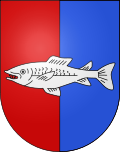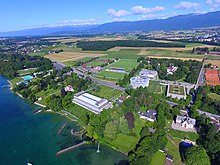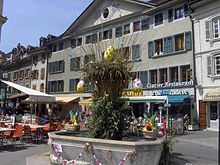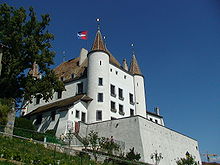Nyon
| Nyon | |
|---|---|
| State : |
|
| Canton : |
|
| District : | Nyon |
| BFS no. : | 5724 |
| Postal code : | 1260 |
| UN / LOCODE : | CH NYO |
| Coordinates : | 507 702 / 137 439 |
| Height : | 403 m above sea level M. |
| Height range : | 372–481 m above sea level M. |
| Area : | 6.80 km² |
| Residents: | 21,198 (December 31, 2018) |
| Population density : | 3117 inhabitants per km² |
| Unemployment rate : | 4.1% (May 31, 2,015) |
| Website: | www.nyon.ch |
|
Nyon |
|
| Location of the municipality | |
Nyon is a political municipality and capital of the district of the same name in the canton of Vaud in Switzerland . The German names Neuis and Neuss come from the time of the Bernese rule and are no longer used today. Under the Celts the place was called Noviodunos ( Latinized Noviodunum ), during the Roman times Colonia Iulia Equestris .
geography
Nyon is 403 m above sea level. M. , 34 km west-southwest of the canton capital Lausanne and 22 km north-northeast of the city of Geneva (linear distance). The community extends on a terrace on the northwest shore of Lake Geneva around 30 m above lake level, between the mouths of the Boiron and the Asse .
The area of the 6.8 km² municipal area comprises a section on the north-west bank of Lake Geneva. The community soil extends from the lakeshore to the northwest over the flat edge of the bank to the slightly elevated plain at the southern foot of the Jura . The valleys of the two rivers Boiron de Nyon (in the southwest) and Asse (in the northeast) are deepened into this plain in the municipality of Nyon . South of the Boiron, the area extends into the Bois Neuf forest area . The highest point of Nyon is 480 m above sea level. M. below Trélex reached. In 1997, 51 percent of the municipal area was accounted for by settlements, eight percent by forests and trees and 41 percent by agriculture.
Nyon includes the commercial and industrial estate L'Asse ( 470 m above sea level ), to the right of the river of the same name, part of the hamlet of Changins ( 436 m above sea level ) south of the Duillier hill and some farm settlements. The neighboring communities of Nyon are Crans-près-Céligny , Eysins , Signy-Avenex , Grens , Trélex , Duillier and Prangins .
Climate table
| Nyon, 1981-2010 | ||||||||||||||||||||||||||||||||||||||||||||||||
|---|---|---|---|---|---|---|---|---|---|---|---|---|---|---|---|---|---|---|---|---|---|---|---|---|---|---|---|---|---|---|---|---|---|---|---|---|---|---|---|---|---|---|---|---|---|---|---|---|
| Climate diagram | ||||||||||||||||||||||||||||||||||||||||||||||||
| ||||||||||||||||||||||||||||||||||||||||||||||||
|
Average monthly temperatures and rainfall for Nyon, 1981–2010
Source:
|
||||||||||||||||||||||||||||||||||||||||||||||||||||||||||||||||||||||||||||||||||||||||||||||||||||||||||||||||||||||||||||||||||||||||||||||||||||||||||||||||||||||||||||||||||||
population
| Population development | |||||||||||
| year | 1850 | 1900 | 1910 | 1930 | 1950 | 1960 | 1970 | 1980 | 1990 | 2000 | |
|---|---|---|---|---|---|---|---|---|---|---|---|
| Residents | 2,417 | 4,882 | 5,096 | 5,107 | 6,064 | 7,643 | 11'424 | 12,842 | 14,747 | 16,182 | |
With 21,198 inhabitants (as of December 31, 2018) Nyon is one of the largest municipalities in the canton of Vaud. 75.9 percent of the residents are French-speaking, 5.7 percent German-speaking and 4.0 percent English-speaking (as of 2000). After 1950 the population increased rapidly and since then the population of Nyon has tripled. The Nyon settlement area has now merged seamlessly with that of Prangins.
politics
The legislative authority is the municipality council ( conseil communal ) elected every four years by the voters of the municipality of Nyon . The 99 MPs are elected by proportional representation. The tasks of the municipal council include budget and invoice approval, the establishment of municipal regulations and control of the executive.
In the Swiss parliamentary elections 2019, the share of the vote in Nyon was: SP 22.8% FDP 21.5%, Greens 20.8%, SVP 13.7%, glp 10.8%, POP / Sol 3.9%, CVP 2 , 6%, EVP 1.3%.
economy
For a long time Nyon was mainly an agricultural town. Today agriculture plays only a minor role as a source of income. Thanks to the fertile soil, it concentrates on arable and vegetable cultivation , while viticulture is practiced on the slopes that are optimally sloping to the south outside the urban area .
The city is an important regional industrial center which, thanks to the excellent transport connections on the Geneva – Lausanne axis, has grown rapidly in recent decades. Important branches of industry are drug production, the food, chemical, metallurgical and match industries, tool, clock and pottery production and graphic arts companies.
The headquarters of the Hublot watch manufacturer , founded in 1980, is located in Nyon , a Novartis plant that produces the cold spray Otrivin and the antimycotic Lamisil and, since 2015, a joint production for non-prescription drugs by Novartis and the British pharmaceutical manufacturer GlaxoSmithKline .
Since Nyon is also considered an administrative and banking center, most jobs are in the service sector. Nyon has been the seat of the UEFA football association since 1995 , which has been organizing the draws for the European Cup competitions at its headquarters since then. In 1988 the Center d'enseignement secondaire supérieur (CESSOUEST) was opened. The fédérale de recherches agronomiques de Changins station, the Swiss Federal Agricultural Research Institute Agroscope, has been located in Changins since 1886 .
Culture
Major cultural events are held in Nyon every year. Above all, this includes the Paléo Festival Nyon , one of the largest open-air festivals in Switzerland. There are also other dance and film festivals, a documentary film festival, including the internationally known Visions du Réel , and concerts. The summer health resort on Lake Geneva is also of touristic importance and has several museums, such as the Musée Romain (since 1979), the Musée du Léman (since 1954) and the Musée historique et des porcelaines (since 1860).
During the Easter season in Nyon - following an old custom - the fountains are decorated with flowers, branches, ribbons and colored eggs (Easter custom).
The École d'ingénieurs de Changins , which trains young oenologists in French-speaking Switzerland, is located in Changins .
traffic
The city has excellent transport connections. It is located on main road 1 from Geneva along the lakeshore to Lausanne . Here the road branches off over the Col de la Givrine to Morez in France . The Nyon motorway junction on the A1 (Geneva – Lausanne) opened in 1964 is around 3 km from the city center.
On April 14, 1858, the section Morges-Coppet was SBB -line Lausanne-Geneva taken with a train station in Nyon in operation. The meter-gauge Nyon – Saint-Cergue – Morez Railway (NStCM) from Nyon to Saint-Cergue , which also opens up Nyon's outlying quarters, was inaugurated on July 12, 1916. From 1905 to 1962 the Nyon – Crassier railway from Nyon to Divonne-les-Bains was also in operation. Today, however, only the section to Eysins is used for goods transport.
Nyon's city bus network takes care of the fine distribution in public transport. There are also postbus courses in the surrounding communities, to Coppet , Gingins and Gimel . Nyon is also connected to the passenger shipping network on Lake Geneva .
history
Nyon can look back on a very long tradition of settlement. The earliest finds date back to the Neolithic , when there was a small settlement on the lake shore.
Celtic and Roman times
In the 1st century BC, the Noviodunos fortification , inhabited by the Helvetians , was located on the site of today's Nyon . Presumably they burned the city down when they moved to Gaul around 58 BC. Forced to return by Caesar , the Helvetii tribes settled back on the shores of Lake Geneva and founded the city of Colonia Iulia Equestris around 45 BC under the supervision of the Romans , which became the most important city on Lake Geneva during Roman times . The center was located on the terrace in the area of the castle at the site of today's old town. It consisted of a forum with a main temple, furnished with rich floor mosaics and a basilica. The first excavations were carried out in the 19th century, further excavations followed in 1974. Little is known about the residential areas. Colonia Iulia Equestris was supplied with water from the Versoix via an aqueduct . Some remains of this partially underground aqueduct have been preserved.
During Roman times, Aventicum ( Avenches ) replaced Colonia Iulia Equestris as the regional center, and Genava (Geneva) also gained more and more importance in the late Roman period . The city was destroyed for the first time after the middle of the 3rd century, but was later rebuilt under the name Civitas Equestri . The final devastation and destruction of the city took place in the 5th century.
Middle Ages and Modern Times
Nyon was re-founded around the 11th and 12th centuries. Initially, the city had the Latinized names Neodunum , Nevidunum , Nividunum , Novidunum , Niviodunum , Noiodunum and Neomagus . Nyon belonged to the Prangins rule and came to the House of Savoy in 1293 . After Nyon received city rights in the 13th century, it experienced an economic boom under the Savoy and became a mint (until the 15th century).
With the conquest of Vaud by Bern in 1536, Nyon was raised to the seat of the bailiwick of the same name. In 1711 the Bonmont Bailiwick was separated from Nyon. After the collapse of the Ancien Régime , the city belonged to the canton of Léman from 1798 to 1803 during the Helvetic Republic, which then became part of the canton of Vaud when the mediation constitution came into force . Nyon has been the capital of the district of the same name since 1798. From 1781 to 1813, the city achieved world renown as the seat of a porcelain factory .
Attractions
Remains of the Roman basilica and the forum can be seen today in the Roman Museum. The three pillars of the former forum, which today stand at the city entrance, testify to the Roman era. The former amphitheater was only discovered in 1996 .
The city complex was built on the Roman foundations and has retained the original floor plan. It still shows a medieval townscape with characteristic patrician houses, mostly in the late Gothic style. The city was fortified under the lords of Prangins in the 12th century; The Tour de César (also called Tour de Rive) is still preserved from this time. Parts of the curtain wall are also visible in the southeast of the old town.
The reformed parish church of Notre-Dame emerged from a former priory church. This was built in the 12th century on the site of a church that was probably built before 700. The current construction of the church dates largely from the 14th century, vaults and side chapels were built between 1471 and 1781. Parts of the choir and the wall paintings have been preserved from the Romanesque period. Major alterations were made in the 18th and 19th centuries, and the bell tower was rebuilt in 1934.
The castle at the east end of the old town was built in the 13th century. It was initially used by the Counts and Dukes of Savoy, and during the Bernese period as a residence for the bailiffs. The original building was greatly expanded and redesigned between 1574 and 1583. The castle has a square floor plan with four side towers. Today it houses the Musée historique et des porcelaines (with a rich collection of porcelain and faience).
The most important buildings in the old town include the Porte Sainte-Marie (from the 18th century), the Maison Bonnard with a tower from the 15th century, and the Hôtel de Ville (also called Maison Lancaster) from the 16th century with sundials on the facade. The former college is a classical building from 1784–1792.
The quarter on the lakeshore below the old town from the 18th to 19th centuries used to concentrate primarily on trade and commerce.
Buildings of modern architecture are also well represented in Nyon.
Town twinning
Since September 8, 2001 there has been a friendship agreement between Nyon and the French city of Nyons in the Drôme department .
Personalities
- Élie-Salomon-François Reverdil (1732–1808), scholar and politician; 1760 to 1767 court master of the Danish Crown Prince and King Christian VII.
- Gustave Falconnier (1845–1913), architect and politician
- Alfred Cortot (1877–1962), French pianist, piano teacher, composer, conductor and music writer
- Louis Mercanton (1879–1932), actor, film director, screenwriter and film producer
- Georges de Mestral (1907–1990), engineer, inventor of the Velcro fastener
- André Haefliger (* 1929), mathematician
- Béatrice Graf (* 1964), jazz musician
- Caroline Cuénod (* 1980), film director
- Ellen Sprunger (* 1986), heptathlete
- Kevin Fickentscher (* 1988), soccer goalkeeper
- Léa Sprunger (* 1990), athlete
- Jean-Lou Treboux (* 1990), jazz musician
Connected to Nyon
- Arnold C. Klebs (1870–1943), Swiss-American medical historian, lived in Nyon
Web links
|
Further content in the sister projects of Wikipedia:
|
||
|
|
Commons | - multimedia content |
|
|
Wikisource | - Sources and full texts |
- Official website of the city of Nyon (French)
- Emmanuel Abetel: Nyon (parish). In: Historical Lexicon of Switzerland .
- Aerial photography
Individual evidence
- ↑ Permanent and non-permanent resident population by year, canton, district, municipality, population type and gender (permanent resident population). In: bfs. admin.ch . Federal Statistical Office (FSO), August 31, 2019, accessed on December 22, 2019 .
- ↑ Demandeurs d'emploi, chômeurs et taux de chômage par commune. ( XLS , 115 kB) Statistique Vaud, Département des finances et des relations extérieures (Statistics Vaud, Department of Finance and Foreign Affairs), accessed on June 14, 2015 (French).
- ↑ Climate table. In: meteoschweiz.admin.ch. meteoschweiz, accessed on June 13, 2018 .
- ^ Federal Statistical Office : NR - Results parties (municipalities) (INT1). In: Federal Elections 2019 | opendata.swiss. August 8, 2019, accessed August 20, 2020 .
- ↑ https://www.handelszeitung.ch/unternehmen/novartis-schphia-der-schweiz-500-stellen
- ↑ https://www.srf.ch/news/wirtschaft/novartis-baut-sich-um-im-grossen-stil











